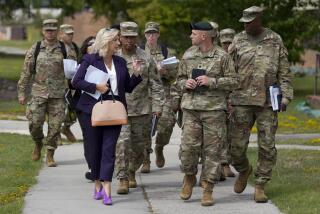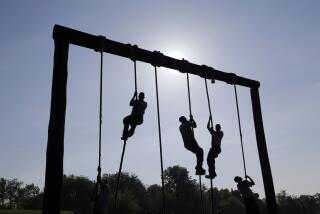Marine Commandant Striving for Leaner, Meaner Fighting Machine
- Share via
PARRIS ISLAND, S.C. — Eighteen-year-old Marine Pvt. Jeff Hickman is down in the dirt, cheek jammed into the metal of an M-60 machine gun that is spitting bone-jolting rounds at an enemy target across the flat marsh.
He leaps from the trench and darts behind a board wall, pokes the barrel through a fake window opening and fires another round. He turns and dives into a nearby sandbag bunker, braces his shoulder and fires again. Wooden pop-up targets lie wounded on the South Carolina marsh.
Hickman, who grew up on Maryland’s Eastern Shore hunting deer and squirrel, is one of the new breed of Marine recruits--the boot-camp troops who are training for Marine Corps Commandant Gen. Alfred M. Gray’s meaner, leaner, green fighting machine.
His Marines do not go to “boot camp” anymore; those grueling, gut-busting first 11 weeks are now called Basic Warrior Training. Marines no longer become mere infantrymen; they are commandos--trained to take a terrorist base in the Persian Gulf as skillfully as they can storm a beach in the South Pacific.
Battle Over Image
In his first 17 months as commandant of the 197,000-member Marine Corps, Gray, a tobacco-chewing bulldog of a general who tromps around the Pentagon in combat fatigues, has waged a crusade to return the service to its “war-fighting image.” He has taken his campaign on the road to a service stung by the Marine embassy guard spy scandals and still haunted by the 1983 bombing that killed 241 Americans at the Marine barracks in Beirut.
“We are warriors and people who support warriors,” Gray, who was the U.S.-based commander of the men who died in Beirut, told a group of Marines during one of his field tours to promote the new image. “We’re not too fancy. We’re not a whole bunch of other things. What you see is what you got.”
In recent years, many Marine leaders weren’t very pleased with what they saw or what they got.
These officers took a dim view of the complex, costly, heavy weapons such as the M-1 tank and AV-8B Harrier jumpjet the Corps helped itself to during the Reagan era’s military buildup. These leaders feared that the Marines were getting too fat and heavy for their mission as an expeditionary force.
Rethinking on Weapons
Battalions were being loaded down by tanks and artillery that would take up valuable ship space and slow the quick-response forces in a war emergency, some officials said. Others argued that the equipment would be useless in the smaller-scale, Third World conflicts that the Marine Corps is most likely to face today. Gray ordered his top officers to rethink how those weapons are used and, in some cases, whether the Corps needs them at all.
Gray and other Marine leaders also were alarmed by their belief that the platoons were inadequately trained in basic combat skills.
“Whoever heard of a marine who wasn’t skilled in weaponry?” growled Chief Warrant Officer Jim Jerrolds, head of training at the Parris Island firing range for the past seven years. “That, unfortunately, was what was happening. We weren’t putting Marines out in the field who were qualified to use all the weapons in an infantry battalion.”
But even as Gray seeks to launch some of the most sweeping changes in the training and structure of his fighting forces since the Vietnam War, and faces the problems of an aging air- and sea-transport force, congressional leaders and budget analysts are warning the new Bush Administration and the Defense Department to brace for an era of sharply declining defense budgets.
‘Tighten Our Belts’
“Things are going to get tighter now,” said Maj. Gen. Michael P. Sullivan, deputy commander for war-fighting, a new position created under Gray to plan the combat needs of the Marine Corps. “There’s only so much to go around. We’ll tighten our belts.”
Meanwhile, Gray is pushing his overhaul of the Marine Corps, beginning with the new recruits--33,400 men and 1,130 women who have enlisted this year.
“We need to teach these high-school graduates with their football letters from East Cupcake, Neb., a little bit about being street-wise,” Gray told a group of sergeants at Cherry Point (N.C.) Marine Corps Station this year.
Since February, the Corps has crammed 60 more hours of training into those rigorous weeks at the Parris Island and San Diego training centers where young “boots” are stripped of their civilian identities--more time on the firing range, more marches, more hand-to-hand combat, more night training, more sweat. Requirements are the same for male and female recruits, although training for the women is tailored to be more defensive than offensive.
Coils of Razor Wire
It is barely daybreak and recruits are slithering on their bellies through the black mud and whining mosquito clouds of a Carolina marsh, inching under coils of razor wire as ear-piercing explosions thunder all around.
In a steamy gymnasium, other recruits are writhing in the chokeholds of their partners in hand-to-hand combat training.
“I want you to start bustin’ heads, OK?” the instructor roars at his panting recruits.
“Yes, SIR!” shouts the panting chorus.
“Poke ‘im in the eye!”
“Yes, SIR!”
The instructor squints mischievously at his red-faced charges: “Are you gonna go home and show grandma what you learned in boot camp?”
“Yes, SIR!”
Late one afternoon, in a scene repeated dozens of times over the course of boot camp, recruits are smearing their faces with greasy streaks of green and brown camouflage makeup--”cammie sticks”--and dressing their helmets with leaves and grass in preparation for a stalk through the thick piney woods in search of “enemy” troops.
‘Creeping and Crawling’
“The recruits are doing the things they sign on to do,” said Maj. Gen. Joseph P. Hoar, commanding general of the Parris Island Recruit Depot, which trains all male Marines who sign up east of the Mississippi and all female recruits nationwide. “They’re caught up in the idea of creeping and crawling through the woods.”
“It’s highly motivating,” said Pvt. Larry Peyton, 18, of Powhatan, Va., during a break on the new firing range, where recruits now spend four days using weapons ranging from M-60 machine guns to anti-tank artillery instead of the old schedule of just one afternoon with M-16 rifles. “It puts more action into the training.”
“It’s good for the Marine Corps,” said squad mate Hickman, who hopes to become an intelligence specialist. “If we ever go to the battlefield, everybody won’t be lost wondering what to do.”
Gray is not satisfied that there is enough extra training in boot camp. Beginning in November, all “boots” are required to go on to more advanced infantry training, whether their occupational specialty is helicopter mechanic or mail clerk.
Shortcomings Revealed
The new emphasis on tougher training was prompted in part by a recent Marine Corps review revealing that many Marines assigned to rear echelon jobs were not capable of defending themselves in combat.
“You have to be able to put down that wrench, pick up your helmet and war belt and defend your airfield if called on,” Hoar said. “That goes for the women as well as the men.”
For men, there will be 28 more days of intensive, advanced field work and weapons training. Women will get an extra seven days of training--a shorter period because it will not focus on offensive tactics and because the smaller number of female recruits requires significantly less training time than the larger groups of male recruits.
Beyond recruit training, the Marine Corps is restructuring its fighting forces, converting eight infantry battalions into commando units.
They train on oil rigs in the Gulf of Mexico and with FBI anti-terrorist forces. Hostage crises, invasions, Third World strikes--Gray wants the Marine Corps there.
“Commandos--by anybody’s definition,” he has said of the new units.
Persian Gulf Operation
When the Joint Chiefs of Staff needed a military force to attack and destroy oil platforms being used as command posts by the Iranian Revolutionary Guard in the Persian Gulf last spring, they called on the new Marine Corps commandos.
“Before, we would not have had that capability,” Gray said.
The Beirut barracks bombing, and his background in intelligence fields, also prompted Gray to order greater emphasis on intelligence-gathering skills, reconnaissance and high-level “war gaming” against perceived enemy threats.
Gray and his officers concede that the new training programs are expensive but say the expense involves time and people more than direct new expenditures. Marine budget analysts note, however, that partly because of the new training the Marine Corps shot more ammunition than it bought this year and had to dig into its reserves for the first time since the Reagan buildup began.
Efforts to Upgrade
But the added training costs are relatively small compared to the mammoth expenses the Marine Corps faces in its efforts to modernize and upgrade its weapons, ships and equipment:
- Over the next 14 years, the service is scheduled to retire 55 of its aging amphibious landing ships and other troop and cargo vessels. It will be competing with the Navy’s need for more destroyers, frigates, submarines and aircraft carriers in a time of shrinking budgets.
- In the next decade, the Marines will introduce their most expensive aircraft ever--the V-22 Osprey tilt-rotor craft for carrying troops and equipment--more than $35 million apiece. The aircraft already is slightly behind schedule and, as a program in its infancy, is expected to encounter expensive growing pains. The total estimated cost is $22.6 billion for 602 Marine Corps and Navy planes.
The introduction of the Osprey follows another major new aircraft acquisition--the Harrier AV-8B, a sleek hybrid of a fighter jet and a helicopter. It can lift off vertically like a helicopter, then shift its jet engines and race across the horizon at speeds of 650 m.p.h. in seconds. Budget cuts already forced the Marine Corps to slash the number of Harriers it requested this year by 25%, but the program is expected to cost $10.4 billion for a total of 276 aircraft.
- The Reagan buildup promised the Marine Corps the money for M-1 tanks--the largest and most powerful tank ever in its inventory. But even before the Corps receives its first M-1 in 1992, the Marine leadership is rethinking whether expeditionary forces such as theirs need such a heavy tank. Gray said that re-evaluation, combined with expected budget cuts, has prompted the Corps to reduce its originally planned M-1 purchases by 60%.
More to Read
Sign up for Essential California
The most important California stories and recommendations in your inbox every morning.
You may occasionally receive promotional content from the Los Angeles Times.










